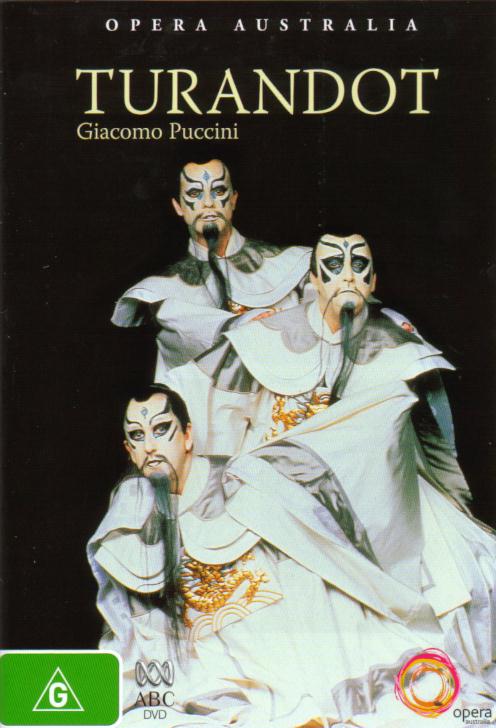Opera Australia-Turandot (1991) |
|
Opera Australia-Turandot (1991) |
|


|
| BUY IT |
| General | Extras | ||
| Category | Opera | Booklet | |
| Rating |

|
||
| Year Of Production | 1991 | ||
| Running Time | 128:09 | ||
| RSDL / Flipper | RSDL (64:55) | Cast & Crew | |
| Start Up | Menu | ||
| Region Coding | 1,2,3,4,5,6 | Directed By | Lindesay Dresdon |
|
Studio
Distributor |
 Roadshow Home Entertainment |
Starring |
Ealynn Voss Kenneth Collins Amanda Thane Donald Shanks David Brennan Graeme Ewer Jonathon Welch Graeme Macfarlane Greg Scott Jin Tea Kim Genevieve Killalea Chloris Vowels |
| Case | Amaray-Transparent-Secure Clip | ||
| RPI | $29.95 | Music | Giacomo Puccini |
| Video | Audio | ||
| Pan & Scan/Full Frame | Full Frame | Italian Dolby Digital 2.0 (384Kb/s) | |
| Widescreen Aspect Ratio | 1.29:1 | ||
| 16x9 Enhancement | No | ||
| Video Format | 576i (PAL) | ||
| Original Aspect Ratio | 1.33:1 | Miscellaneous | |
| Jacket Pictures | No | ||
| Subtitles | English | Smoking | No |
| Annoying Product Placement | No | ||
| Action In or After Credits | No | ||
Turandot was Giacomo Puccini's final opera, left unfinished at his death in 1924. He had completed the score including orchestration up to the final scene. He was diagnosed with throat cancer while working on this scene and died of a heart attack following radiation treatment and surgery, leaving several pages of sketches behind. Despite his wish that fellow composer Riccardo Zandonai complete the work in the event of his death, Puccini's son eventually chose Franco Alfano to write the score for the final scene.
Alfano's first version of the final scene was rejected by Puccini's publisher Ricordi and conductor Arturo Toscanini. A rewrite was done to make it shorter and more consistent with the sketches and notes left by the composer. The first performance in 1926, conducted by Toscanini, did not even include Alfano's completion but left off at the point where Puccini had laid down his pen for the last time. Subsequent performances have included Alfano's second ending and the opera has been very popular ever since, being regularly performed all over the world.
I have heard a recording of Alfano's original ending and it does sound superior to the second version, though to be honest neither ending has the level of inspiration of the rest of the opera. The second Alfano ending requires a strong performance to make it work on a musical level. In recent years the late Italian composer Luciano Berio attempted a new version of the ending but with little success in my opinion.
The performance on this DVD was part of the Esso Night at the Opera series, which at the time it was screened involved a simulcast on ABC-TV and Classic FM. It comes from a live performance at the Victorian Arts Centre by Opera Australia on 30 April 1991. The attraction of this performance is not so much the singers but the production itself. While international plaudits are many for Baz Luhrmann's production of La Boheme, it is perhaps this production of Turandot, directed by Graeme Murphy and designed by Kristian Fredrikson, that represents the high water mark of Opera Australia's 50 year history. Using lighting or the absence thereof to cover the relative bareness of the sets, a few large scale backdrops and imaginative use of props and costumes set this production apart. It suggests a grandeur beyond the intimate scale of the production while concentrating the focus on the drama of the work.
While the singers are perhaps not of the highest calibre, the overall result is that this is the best and most satisfying realisation of the work available on DVD. It makes a useful comparison with Franco Zeffirelli's monstrously overblown 1989 Met production, which has the advantage of big names (Domingo and Marton in the lead roles, plus the then 87-year-old Hugues Cuénod as Emperor Altoum) but seems empty as the production design swamps the drama. Leaden conducting by James Levine does not help either. The Australian production features Ealynn Voss in the title role. While she is adequate vocally most of the time she sometimes doesn't quite hit the notes accurately. Visually she does not convince as the Ice Princess who steals Calaf's heart with his first glimpse of her, but given the unusual demands of so many high notes there have been few sopranos who can satisfy the vocal demands without looking like the proverbial brick outhouse. I don't think she is a local singer (probably an American), but the only definite information I can find about her background is that her real name is Lynn Winkelvoss.
Kenneth Collins sings Calaf with conviction, though also with occasional raggedness and strain. His rendition of the famous aria Nessun Dorma is not in the Pavarotti league to be sure, though the latter does not really have the type of voice the role calls for. Ironically though Nessun Dorma is considered his signature tune, Pavarotti rarely sang the complete role. He recorded it once on record and performed it in 1975, but then avoided the part for 22 years until returning to it in 1997 for performances at the Met. Calaf requires a tenor with some good loud, lower notes, while the rotund Italian was more suited to the higher range lyrical vocal demands of, say, Donizetti, Bellini and Verdi.
Amanda Thane is probably the best of the singers as the ill-fated Liu, with Donald Shanks not far behind as Calaf's father Timur. Ping, Pang and Pong are also well served. The conducting of Opera Australia regular Carlo Felice Cillario tends to linger over the more lyrical parts of the score, and this performance has one of the slower renditions of Non piangere Liu that I have heard. It works quite well and Alfano's finale comes across as very convincing, being unrushed and performed with conviction and strong drama.
My only cavil with this presentation is that the TV direction can be a little clumsy, at times missing some of the spectacle by using close-ups, and at others missing some of the drama by not showing reaction shots. All in all though this is a very good bargain.
The transfer is in the original television aspect ratio of 1.29:1.
The analogue video shows its age as well as the problems to be expected from theatrical lighting, though there is a credit for television lighting at the end, so it would not be as poor as it might have been if standard lighting was used. Much of the production uses minimal lighting to achieve the effects (and presumably to reduce costs by not having a large set). As a result the video is a little on the dark side, and detail is often compromised by this. The video is as sharp as could be expected.
What looked like fairly vivid colour in the costumes and sets is a little muted. Whites are well rendered. It's hard to tell whether flesh tones are accurate as most of the performers have lots of makeup on.
The transfer shows the usual problems with older video, having numerous small compression artefacts. There is also some mild aliasing appearing infrequently. There is also plenty of macro-blocking, particularly affecting the Emperor's large costume. There are no film artefacts of course.
Optional English subtitles are provided, in a rather thick white font that is easy to read. An occasional line is unsubtitled, but this does not compromise understanding of the story.
The disc is RSDL-formatted. I did not notice any layer change while watching the opera. Further investigation reveals that the layer break occurs at 64:55 during a break in the music of Act II.
| Sharpness | |
| Shadow Detail | |
| Colour | |
| Grain/Pixelization | |
| Film-To-Video Artefacts | |
| Film Artefacts | |
| Overall |
The only audio option is Dolby Digital 2.0, in stereo without surround encoding. I wish the ABC had instead included a Linear PCM track, as the higher bitrate would have made the sound even better.
I was surprised at how well the audio scrubs up. I expect that the recording of the audio for FM broadcast led to there being much better source material than if it had been recorded for TV broadcast only. There is very good stereo separation and a clear soundstage, reflecting the position of the singers and orchestra as viewed from the centre of the audience. This does not always match the visuals due to the camera positions and the use of medium close-ups.
The orchestra is forwardly placed in relation to the voices, much as it is in the concert hall. The volume level is slightly higher than normal, so I had the volume down a couple of notches from reference level. Even so it was louder than I normally prefer, but to hear the voices clearly you have to have the orchestra up loud.
The only drawback of the Dolby Digital compression is that there is a steeliness to the voices and strings indicating a loss of some of the higher frequencies. Otherwise everything is clear and sounds realistic. There is plenty of detail with individual instruments audible. Bass is plentiful even without a low frequency effects channel, so it is fortunate that there are few stage thumps and bumps, though in the final act these are more prominent.
| Dialogue | |
| Audio Sync | |
| Clicks/Pops/Dropouts | |
| Surround Channel Use | |
| Subwoofer | |
| Overall |
The sole extra is a four page booklet with a synopsis of each act and a detailed list of credits.
NOTE: To view non-R4 releases, your equipment needs to be multi-zone compatible and usually also NTSC compatible.
This performance has been released by the Kultur label in Region 1. It is a PAL to NTSC conversion so in terms of video quality the Region 4 would have to be preferred. The Region 1 also has Dolby Digital 2.0 sound and is more expensive than the Region 4, so there is no need to shop overseas.
A fine performance of a splendid production of Puccini's final work, this is unlikely to be bettered in the foreseeable future.
The video quality is good but limited by the original recording.
The audio quality is excellent all things considered.
No extras of note.
| Video | |
| Audio | |
| Extras | |
| Plot | |
| Overall |
| Review Equipment | |
| DVD | Sony DVP-NS9100ES, using HDMI output |
| Display | Sony VPL-HS60 LCD Projector projected to 80" screen. Calibrated with Digital Video Essentials (PAL). This display device is 16x9 capable. This display device has a maximum native resolution of 720p. |
| Audio Decoder | Built in to DVD Player, Dolby Digital and DTS. Calibrated with Ultimate DVD Platinum. |
| Amplification | Sony TA-DA9000ES for surrounds, Elektra Reference power amp for mains |
| Speakers | Main: B&W Nautilus 800; Centre: Tannoy Sensys DCC; Rear: Tannoy Revolution R3; Subwoofer: Richter Thor Mk IV |